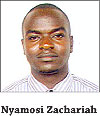Harmonizing the curriculum and affecting the draft protocol on the establishment of East African Science and Technology Council are probably among the most exuberant products of the marriage between the East African Community member states.


Harmonizing the curriculum and affecting the draft protocol on the establishment of East African Science and Technology Council are probably among the most exuberant products of the marriage between the East African Community member states.
While Uganda and Tanzania retained the colonial 7-4-2-3 system, Kenya shifted to the 8-4-4 system. Rwanda is now on the Anglophone 6-3-3-4 system. Burundi is still francophone.
The differences in the curricula are as vast as they numerically appear.
EAC partner states have identified the harmonization of the education curricula, standards, assessment and evaluation of education programs as a priority issue.
The proposed harmonization of the curricular process started in 1998 with Kenya, Uganda and Tanzania exchanging their national curricula documents for review.
The process has produced country position papers on areas where the curricula of a particular country converges and diverges with the other partner states.
The EAC is undertaking a comparative study in the partner states with a view of harmonizing the national goals and philosophies of education, curriculum content, education structures, policies and legal framework.
This process may not be as simple as it appears on paper. The interests of the partner states are as diverse are the people.
The structure and content of any country’s curriculum is determined by any country’s unique needs, politics and philosophies. Harmonizing all this is a daunting task.
Whatever it takes, a harmonized EAC curriculum is the way to go.
When the old EAC was using the same curriculum before its collapse in 1977, there was no doubt of the quality of education that anyone received in any of the member states.
The centralized system ensured that uniform standards were upheld across the divide.
Students should not move from Rwanda, say, to study in another country within the EAC because of the supposed feeling of getting superior education there.
Any such movement should just be out of choice of movement as a result of the free movement of people and goods within the EAC.
The curriculum harmonization, which is to encompass institution of a unitary academic calendar, is likely to be a gold mine for Rwandan teachers who may want to study in the other EAC member states.
Teachers who may wish to study on the sandwich programs outside Rwanda find it difficult because the April and August holidays in Rwanda are shorter than those of the other EAC member states.
With the universities across the EAC member states opening campuses across the economic bloc, a ray of hope has descended on those seeking qualifications from those universities.
The advancement in ICT has also necessitated lifelong education. Many people are now able to study from their homes. The abundance of quality online programs has managed to shift the traditional school to the laptop.
Much will be achieved if the draft education protocols are ratified and implemented. By so doing, there will be sustainable development among the EAC member states as quality education hold the key to producing able human resource to facilitate social and economic development.


